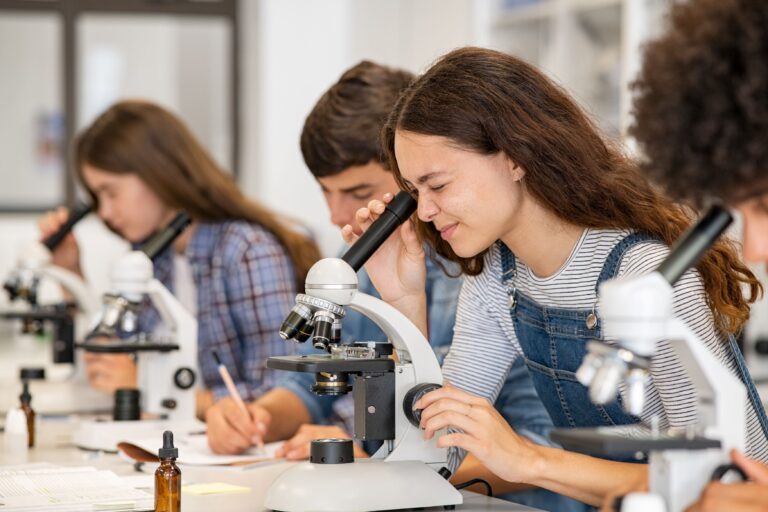As students move into middle and high school, it becomes increasingly challenging for them to maintain excitement and enthusiasm for subjects like math and science. This difficulty could be because this age group tends to be distracted by their social life and other outside activities, which makes it hard for teachers to capture and hold their student’s attention.
Employing innovative strategies to reignite students’ interest is essential to address this challenge. Here we’ll explore a few key areas to help you make science class more appealing so your older students will get excited about science class again.
Igniting Curiosity: Reframing Science as Relevant and Real
An effective way to ignite curiosity in science class is to connect science to everyday life, current events that are happening right now, and potential career opportunities that they may want to pursue in the future. By showcasing real-world relevance, you are making the subject more relatable and interesting.
Connecting Science to Careers
To help pique the interest and inspire older students, you can discuss the various career opportunities science has to offer. Guest speakers can share their experiences and offer insight into the field of science. Hearing directly from these professionals makes having a career in science more tangible.
Assigning career-themed projects is another way to make a real-world connection to science. For example, a physics engineering challenge like designing a machine or device can help demonstrate the application of physics in engineering. Additionally, arranging a field trip to a science-related workplace like a technology company can help students understand and appreciate how professionals apply their knowledge in real-world settings.
Science in the News
Discussing current scientific events, such as scientific breakthroughs or medical advances, can help demonstrate science’s relevance to the world. When students see that these scientific discoveries impact society, it will help to make the connection between what they are learning in the classroom and the outside world. By incorporating these real-world events you are making science more intriguing and relevant.
Hands-on Engagement: Beyond the Textbook and Lecture
To captivate the attention of older students it’s essential to look beyond traditional teaching methods like textbooks and lectures. Hands-on, interactive activities can engage students and make science class more exciting.
Hands-on Experiments
Conducting more hands-on experiments is a great way to make science class more fun, and it will help reinforce science concepts as well as help students develop essential skills like critical thinking, problem-solving, and collaboration. For example, try connecting chemistry to real life by simply demonstrating the reaction of baking soda and vinegar, which produces carbon dioxide, causing a volcano eruption. This experiment will help make science more relatable and foster a deeper understanding of chemical reactions in everyday life.
Project-Based Learning
Project-based learning involves actively involving students in real-world scenarios and challenges. Having students choose a science project that requires research and experimentation empowers them to take ownership of their learning. For example, students may create an eco-friendly greenhouse requiring research, design, prototype, analysis, reflection, and so on. This type of project fosters student’s creativity and curiosity all while getting them excited about science.
Bringing Science to Life: Creative and Immersive Experiences
Creating more captivating learning experiences will make your science class more interesting and enjoyable. You can do this by incorporating technology. Here are a few ideas.
Virtual Lab Simulations
Virtual Lab simulations that offer interactive experiments allow students to explore science concepts digitally. Websites such as Labster, Gizmos, and LabXchange, allow students to interact with lab materials in a virtual lab without the constraints of physical equipment they may not have access to in the classroom. For example, students can learn how to fly an airplane through a computer simulation. These simulations can help to enhance a student’s learning experience.
Augmented Reality
AR technology can enhance student learning by providing them with an immersive learning experience. What augmented reality apps do is enhance real-world objects by adding an interactive layer to what you are already seeing. For example, science teachers can use an AR app like Brainapse to explore human anatomy or use an AR app like Plant ID to help identify plants. This can help improve student’s learning experience and understanding of complex concepts by applying knowledge to a real-world experience.
Science-Related Podcasts
Podcasts are increasingly popular among older students mostly because they provide a hands-free way to listen, so students can multitask. Since podcasts are easily accessible and offer a diverse range of topics, you can have students listen to podcasts that explore a wide range of science topics. Some engaging podcasts that may resonate with older students are, “Science for the People” by Desiree Schell, “Brains On!” by American Public Media, and “Science Vs” by Wendy Zukerman.
3D Printing
3D printing technology enhances hands-on learning and can help students better understand abstract ideas. It offers an innovative way to engage students in a variety of science topics. Whether it’s exploring a multi-layer cell, building a DNA model, or constructing a geological formation, 3D printing is a great way to boost students’ understanding and learning.
Virtual Guest Lectures
Arrange video conferences with experts in the field of science. This will help students gain insight with professionals in specific scientific fields. For example, Skype a Scientist is a popular platform that connects you with thousands of scientists from across the globe. This allows students to have a virtual Q and A session and get their answers straight from an expert.
Getting older students excited about science class can be achieved with a little forethought. By incorporating innovative, hands-on experiences that are both relevant and engaging, you will captivate learners and foster a lifelong love for science. Connecting science to current events and potential careers and utilizing technology will help sustain student interest and equip students with the knowledge and skills they need for the future.




